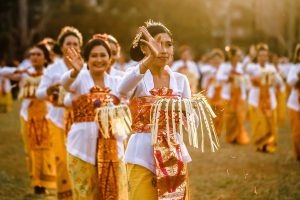Indonesia, an archipelagic country straddling the equator, is known for its tropical climate, warm temperatures, and diverse weather patterns across its 17,000 islands. With two main seasons—the dry season and the rainy season—understanding the month-by-month weather variations is crucial for travelers planning their perfect Indonesian adventure. From Bali’s sunny beaches to Sumatra’s rainforests and Java’s volcanic landscapes, the country offers unique experiences throughout the year. This ultimate guide breaks down Indonesia’s weather month by month, helping you determine the best times to visit and what to expect in different regions.
Indonesia’s weather is influenced by monsoons, ocean currents, and geographical variations across its vast expanse. Some islands experience heavier rainfall than others, while some have microclimates that defy traditional seasonal patterns. Traveling at different times of the year will shape your experience—from witnessing lush green landscapes during the wet season to basking in dry, sunny conditions perfect for island hopping and adventure activities. This comprehensive guide provides all the insights you need to make the most of your trip, no matter when you visit.
January: Wet and Warm Start to the Year
Weather: January is part of Indonesia’s wet season, with heavy rainfall across most islands. Humidity levels are high, and thunderstorms are frequent, especially in Jakarta, Sumatra, and Kalimantan. Bali and Lombok also experience significant rain but still have occasional sunny breaks.
Best Destinations: While most regions are wet, diving in Raja Ampat is spectacular during this time as the visibility is excellent. North Sulawesi and the Maluku Islands also offer great underwater experiences. If you don’t mind the rain, exploring cultural sites in Yogyakarta or visiting indoor attractions in Jakarta is a good option.
Travel Tips: Pack waterproof gear and be prepared for possible flight or ferry delays due to rain. Some national parks may have restricted access due to muddy trails. This is also the season when mosquitoes are more prevalent, so carrying insect repellent is essential.

February: Rain Persists but Crowds are Low
Weather: February remains rainy, with high humidity and occasional floods in urban areas like Jakarta. Sumatra and Borneo continue to receive downpours, while Bali and the Gili Islands start seeing slightly better weather.
Best Destinations: Raja Ampat remains an excellent diving destination. For cultural experiences, Yogyakarta and Ubud offer indoor attractions like temples, museums, and art galleries. If you’re looking for a relaxing retreat, eco-resorts in North Sulawesi offer beautiful rainforest views.
Travel Tips: Prices for accommodations are lower, making it a great time for budget travelers. Avoid remote trekking areas that may be affected by landslides. Traveling in February means you will encounter fewer tourists, allowing you to explore famous sites with more solitude.
Also read: 10 Fascinating Facts About Jungle Ecosystems In Bukit Lawang
March: The Transition Month
Weather: Rain begins to subside towards the end of the month, though occasional showers still occur. Temperatures remain warm, averaging 27-30°C (81-86°F). The air is fresher as the landscape is still green from the recent wet season.
Best Destinations: Bali, Lombok, and Komodo National Park start becoming more accessible for outdoor activities. Flores and Sumba begin drying up, making them ideal for adventure travelers. The Togean Islands in Sulawesi are also a hidden gem worth visiting.
Travel Tips: This is a good month for those who want to avoid peak-season crowds while still catching decent weather. The transition between the wet and dry season makes the landscapes particularly photogenic, with waterfalls at their most powerful.
April: Start of the Dry Season
Weather: Rainfall decreases significantly, and the dry season officially begins in some regions. The sky is clearer, and humidity drops slightly, making it a pleasant time to explore outdoor attractions.
Best Destinations: Bali, Lombok, and Java’s cultural sites, such as Borobudur and Prambanan, are perfect for exploration. Hiking trails on Mount Bromo and Ijen become more accessible. This is also a great time to visit Tana Toraja in Sulawesi for unique cultural experiences.
Travel Tips: April is one of the best months to visit before the crowds arrive. Book early for accommodations as demand starts picking up. Consider renting a motorbike in Bali or Lombok for independent exploration of lesser-known beaches and waterfalls.
May: Ideal Travel Conditions
Weather: One of the best months to visit Indonesia, with warm temperatures, clear skies, and minimal rainfall. Perfect for outdoor adventures and beach vacations.
Best Destinations: Surfing in Bali and Lombok is excellent, while Sumatra’s wildlife parks, such as Bukit Lawang, offer great orangutan sightings. Java’s Dieng Plateau offers cooler temperatures and breathtaking highland views.
Travel Tips: May offers perfect conditions without the summer crowds. A great time for island hopping, snorkeling, and diving in places like Komodo and the Nusa Islands.
June: Beginning of Peak Season
Weather: Dry, sunny, and warm, making it one of the most popular months for tourism. The visibility in the ocean is at its peak, making it great for diving.
Best Destinations: Bali, the Gili Islands, Komodo, and Java’s cultural heritage sites. Kalimantan is also great for spotting orangutans, and Sumatra’s Lake Toba is a refreshing retreat.
Travel Tips: Prices begin to rise. Book flights and accommodations in advance. Attend local festivals such as the Bali Arts Festival.
July: Peak Season and Perfect Weather
Weather: Sunny and dry with low humidity. The best conditions for outdoor activities and marine excursions.
Best Destinations: Bali, Lombok, Komodo, Flores, and Raja Ampat. Java’s volcano hikes, such as Mount Rinjani, are spectacular during this month. Sumba’s Pasola festival is also a highlight.
Travel Tips: Expect crowds in tourist hotspots. Book everything in advance, from accommodations to ferry tickets.
August: Prime Dry Season and Festivities
Weather: August is one of the driest months in Indonesia, offering warm temperatures, clear skies, and low humidity. It is an excellent time for outdoor adventures, beach relaxation, and cultural events.
Best Destinations: Bali is at its peak tourist season, with ideal weather for sunbathing, surfing, and diving. Komodo National Park is a fantastic choice for wildlife enthusiasts, while Java’s cultural and historical landmarks shine under the clear skies. Sumatra’s Mentawai Islands provide world-class surfing conditions, and Sumba’s breathtaking landscapes are perfect for exploring.
Travel Tips: Since August coincides with European and Australian summer holidays, expect large crowds in popular areas like Bali, Lombok, and the Gili Islands. Book accommodations and activities in advance, and consider visiting lesser-known islands for a quieter experience.
September: The Start of Shoulder Season
Weather: Still part of the dry season, September maintains excellent weather conditions with slightly fewer crowds compared to July and August.
Best Destinations: The Nusa Islands (Nusa Penida, Nusa Lembongan, and Nusa Ceningan) offer spectacular beaches and diving spots. Flores and Komodo remain great for exploration, and Java’s Bromo and Ijen volcanoes provide stunning trekking opportunities.
Travel Tips: With fewer tourists, September is a great time to explore Indonesia’s hotspots without the peak-season chaos. You can also take advantage of lower hotel prices and tour packages compared to July and August.
October: The End of the Dry Season
Weather: October signals the transition from the dry to the rainy season. While the first half of the month remains relatively dry, some islands start experiencing increased rainfall, particularly in Sumatra and Kalimantan.
Best Destinations: This is a great time to visit Bali and Lombok before the rainy season arrives. The Banda Islands in Maluku are also excellent for diving, as marine life is at its most vibrant.
Travel Tips: Monitor weather updates, as some regions may experience occasional storms. Travel flexibility is key during this period.
Also read: 7 Essential Items To Pack For A Bukit Lawang Jungle Trek
November: Rainy Season Begins
Weather: November marks the onset of the rainy season across most of Indonesia. Humidity increases, and heavy downpours become frequent, though they are often short-lived.
Best Destinations: Raja Ampat enters its best diving season, making it a top destination despite the increased rainfall elsewhere. Cultural exploration in Yogyakarta and Bali’s Ubud is still enjoyable, as many attractions are indoors or semi-sheltered.
Travel Tips: Be prepared for occasional travel disruptions due to heavy rain. Waterproof gear is essential, and alternative indoor activities should be considered.
December: Lush Landscapes and Festive Atmosphere
Weather: December is characterized by regular rainfall and high humidity, yet it remains a popular month due to holiday festivities. Lush green landscapes return, and waterfalls become more powerful.
Best Destinations: Raja Ampat continues to offer unbeatable diving experiences. Bali and Jakarta are vibrant with Christmas and New Year’s celebrations, attracting international and domestic tourists alike.
Travel Tips: Book accommodations and flights early due to the high holiday demand. Be mindful of potential travel delays due to weather conditions.
Conclusion
Indonesia is a year-round destination, but choosing the right month can greatly enhance your travel experience. The dry season (April to October) is ideal for beach lovers, hikers, and outdoor enthusiasts, while the rainy season (November to March) offers lush landscapes, fewer crowds, and incredible diving in Raja Ampat. Whether you’re looking for adventure, relaxation, or cultural immersion, this month-by-month guide will help you plan the perfect Indonesian getaway. Regardless of when you visit, Indonesia’s warm hospitality, rich biodiversity, and vibrant culture ensure an unforgettable experience.

Alfath Dewantara is the manager of Jungle Inn Hotel in Bukit Lawang and a leading expert in Bukit Lawang eco-travel. With years of experience in sustainable tourism, he is dedicated to preserving the region’s rich biodiversity while providing authentic jungle experiences for visitors.




